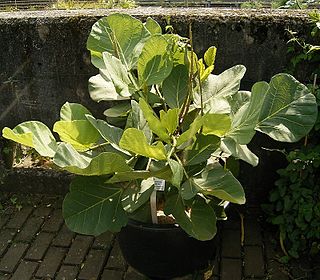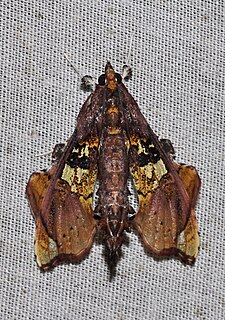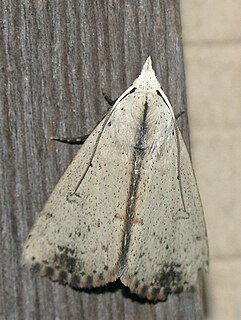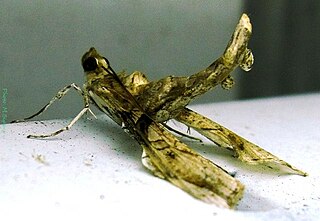
Erythrina is a genus of flowering plants in the pea family, Fabaceae. It contains about 130 species, which are distributed in tropical and subtropical regions worldwide. They are trees, with the larger species growing up to 30 m (98 ft) in height. The generic name is derived from the Greek word ερυθρóς (erythros), meaning "red", referring to the flower color of certain species.

Erythrina herbacea, commonly known as the coral bean, Cherokee bean, Mamou plant in South Louisiana, red cardinal or cardinal spear, is a flowering shrub or small tree found throughout the southeastern United States and northeastern Mexico; it has also been reported from parts of Central America and, as an introduced species, from Pakistan. Various other systematic names have been used for this plant in the past, including Erythrina arborea, Erythrina hederifolia, Erythrina humilis, Erythrina rubicunda, Corallodendron herbaceum and Xyphanthus hederifolius.

Erythrina crista-galli, often known as the cockspur coral tree, is a flowering tree in the family Fabaceae, native to Argentina, Uruguay, southern Brazil and Paraguay. It is widely planted as a street or garden tree in other countries, notably in California. It is known by several common names within South America: ceibo, seíbo (Spanish), corticeira (Portuguese) and the more ambiguous bucaré, to name a few. Its specific epithet crista-galli means "cock's comb" in Latin.

Erythrina variegata, commonly known as tiger's claw or Indian coral tree, is a species of Erythrina native to the tropical and subtropical regions of eastern Africa, the Indian Subcontinent, northern Australia, and the islands of the Indian Ocean and the western Pacific Ocean east to Fiji.

Erythrina vespertilio is a tree native to north and north-east Australia. Its common names are grey corkwood, bat's wing coral tree, yulbah and the more ambiguous "bean tree". In the Western Desert language it is also known as ininti.

Erythrina coralloides is a species of flowering tree in the pea family, Fabaceae, that is native to eastern Mexico. It ranges from Tamaulipas south to Oaxaca, and some taxonomists believe it is also native to southern Arizona in the United States.

Erythrina humeana is an ornamental tree native to South Africa.

Erythrina fusca is a species of flowering tree in the legume family, Fabaceae. It is known by many common names, including purple coraltree, gallito, bois immortelle, bucayo, and the more ambiguous "bucare" and "coral bean". E. fusca has the widest distribution of any Erythrina species; it is the only one found in both the New and Old World. It grows on coasts and along rivers in tropical Asia, Oceania, the Mascarene Islands, Madagascar, Africa, and the Neotropics.

Erythrina caffra, the coast coral tree or African coral tree, is a tree native to southeastern Africa, which is often cultivated and has introduced populations in California and India. All the 17 species of coral tree in the genus Erythrina are collectively considered the official tree of Los Angeles, California in the United States.

Agathodes is a genus of moths of the family Crambidae. The genus was first described by Achille Guenée in 1854.

Terastia is a genus of snout moths in the subfamily Spilomelinae of the family Crambidae. It was described by Achille Guenée in 1854 with Terastia meticulosalis as type species. The genus is currently placed in the tribe Margaroniini, where it is closely related to the genera Agathodes and Liopasia.

Erythrina × bidwillii is the scientific name for two different cultivars produced from hybridising Erythrina species at Camden Park Estate, New South Wales, Australia, in the early 1840s by William Macarthur, one of the most active and influential horticulturists in Australia.

Scolecocampa liburna, the dead-wood borer, is a moth in the family Erebidae. The species was first described by Carl Geyer in 1837. It is found in the US from southern Wisconsin and Michigan to central New England south to Florida and Texas.
Terastia meticulosalis, the erythrina twigborer or erythrina borer, is a moth of the family Crambidae. It has a wide distribution. In North America, it has been recorded from south-eastern Arizona, southern Texas, Louisiana and Florida. It is also present in Jamaica.

Terastia subjectalis is a moth of the family Crambidae. It occurs across the Indian and south Pacific oceans, including Fiji, Hawaii, Réunion, Okinawa, Samoa, the Society Islands, Sri Lanka and Australia.
Agathodes musivalis is a species of moth of the family Crambidae described by Achille Guenée in 1854. It is found in Mayotte, Congo, Kenya, Réunion, Malawi, Mauritius, Madagascar, Mozambique, Somalia, South Africa, Uganda, Zambia and Zimbabwe.
Agathodes designalis, the sky-pointing moth, is a moth in the family Crambidae. It was described by Achille Guenée in 1854. It is found from the southern United States, where it has been recorded from Arizona, Texas and Florida, south to southern South America. It is also found on the West Indies.
Agathodes modicalis is a moth in the family Crambidae. It was described by Achille Guenée in 1854. It is found in India, Indonesia and in South Africa (KwaZulu-Natal).
Agathodes paliscia is a moth in the family Crambidae. It was described by Turner in 1908. It is found in Australia, where it has been recorded from Queensland and Western Australia.















